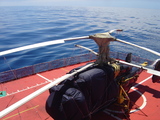- ALSA Home
- →
- Photo Gallery
- →
- Antarctica SANAE
- →
- View Item
JavaScript is disabled for your browser. Some features of this site may not work without it.
| dc.contributor.author | Combrinck, Ludwig | Combrinck, Attie | |
| dc.coverage.spatial | Antarctica | |
| dc.date.accessioned | 2018-09-25T05:47:36Z | |
| dc.date.available | 2018-09-25T05:47:36Z | |
| dc.date.created | 2007-2008 | |
| dc.date.created | 2007-2008 | en_ZA |
| dc.date.issued | 2007-2008 | |
| dc.date.issued | 2007-2008 | |
| dc.identifier.uri | http://hdl.handle.net/123456789/10605 | |
| dc.description.abstract | 2007-08 Summer Relief Expedition South African National Antarctic Programme. Ludwig Combrinck and Attie Combrink departed from Cape Town on 4 December 2007, onboard the S.A. Agulhas Voyage 140.Our first stop-over was at Bouvet Island in the South Atlantic Ocean, also referred to asthe most remote place on Earth, to drop off fellow scientists who would spend the summer on the island, working with the seal and penguin colonies.The pack-ice this summer extended approximately 1,000 km from the continent. We encountered icebergs around Bouvet and travelled in the pack-ice from approximately 60degrees South. In the end it took us 26 days to reach Antarctica, and on some days the ship was completely stuck and we could make no progress.Upon entering the Antarctic circle at 66degrees 33 South, we newcomers to King Neptune’s kingdom first had to meet his wrath. We were dunked in sea water at –2degrees Celsius -this is possible because of the water’s salinity-, introduced to the king and queen who blessed us with their foodstuff, and then got the sweet juice to swallow. Now we also belong to the Order of Antarctic Fellows -O.A.F.-.Fortunately, we had many companions on our journey… birds, seals and a few whales.Upon reaching the ice shelf, the first task was to bulldoze a ramp for offloading cargo, after which passengers were flown to the base.The South African permanent research base in Antarctica, SANAE IV -the 4th South African National Antarctic Expedition base-, is located on the Southern Buttress of Vesleskarvet -the right-hand side of the picture below-, a mountain in Western Dronning Maud Land in the Norwegian Antarctic Territory, 71degrees 40 South 2degrees 51 West.Being located in a desert, i.e. having very little annual precipitation, requiressmelly duty where each person gets a turn to shovel a few tonnes of snow over the course of a day into a snow melter in order to make water for the base occupants.The base has an amazing view over the mountains to the south… this was the view we had from our office - laboratory.Doing much work in the field, allowed us the opportunity to travel quite a bit from SANAE IV: we visited Knotten -20 km northeast-, Lorenzenpiggen -7 km south- and Grunehogna -40 km south-.Dr. Ludwig Combrinck and Dr. Attie Combrink from HartRAO Space Geodesy Programme, at 72degrees South.Out in the field we installed radar reflectors -for the South African Hydrographer to calibrate Antarctic coastline maps produced by radar images taken from satellite- and GPS self-centring plates -to determine whether the Earth’s crust deforms locally-. Thereafter we surveyed the positions of these new installations with state-of-the-art GPS equipment.Travelling to these places required transport in the form of skidoos or helicopter. We also had the chance to experiment with more outdated modes of transport.We also had the opportunity to visit our Norwegian colleagues at the Troll Base. They use a Toyota Hilux for transporting VIPs from the airfield, such as the Prime Minister who visited the previous week to officially inaugurate the new base.Other work included the measuring of horizon profiles using a theodolite……or measuring atmospheric turbulence by observing and photographing astronomical sources such as the Moon or Venus.Ludwig set up a commemorative radio station for Admiral Byrd -early Antarctic explorer- and made the first AM contacts from Antarctica in probably 40 years, using his Collins equipment.Fortunately there is also time for entertainment, like having a braai……or a formal dinner…As in the past, the Scientist Team won the toughest battle of all, the tug-of-war. Meet the champions:“Windscooping is an activity well-suited for summer afternoons or evenings, when the Sun is only a few degrees above the horizon in the southwest. The activities at the windscoop include snowboarding, skiing, sliding downhill on a mattress -the current speed record is 90 km-h- or climbing ice walls with an ice-pick.So if you can stay as warm as Ludwig with his Ukrainian rabbit-skin headwear, Antarctica could be the biggest party island of them all. | en_ZA |
| dc.description.sponsorship | Sponsored by the National Research Foundation (South Africa) | |
| dc.description.statementofresponsibility | Antarctic Legacy Project | |
| dc.language | en_ZA | |
| dc.rights | copyright | |
| dc.subject | SANAE|satellite|gps|radiosone|geography|installations | |
| dc.title | 2007 Voyage to SANAE IV | |
| dc.type | Images | |
| dc.rights.holder | Antarctic Legacy of South Africa | en_ZA |
| iso19115.mdconstraints.uselimitation | This item and the content of this website are subject to copyright protection. Reproduction of the content, or any part of it, other than for research, academic or non-commercial use is prohibited without prior consent from the copyright holder. | en_ZA |
| iso19115.mddistributor.distributorcontact | Combrinck, Ludwig | Combrinck, Attie | en_ZA |
| iso19115.mdformat.name | JPG | en_ZA |
| iso19115.mdidentification.deliverypoint | Antarctic Legacy of South Africa, Faculty of Science, Private Bag X1, Matieland. Stellenbosch. South Africa. | en_ZA |
| iso19115.mdidentification.electronicmailaddress | antarcticlegacy@sun.ac.za | en_ZA |
Files in this item
This item appears in the following Collection(s)
-
Antarctica SANAE [9727]
Images taken on Antarctica and on the way to and from Antarctica.

